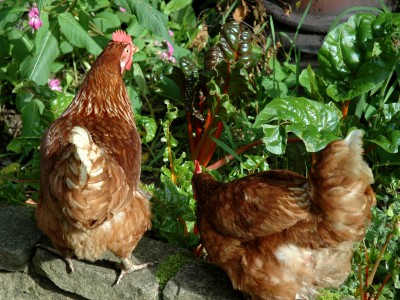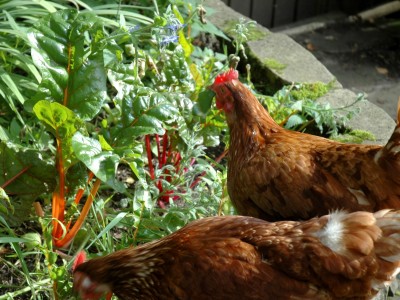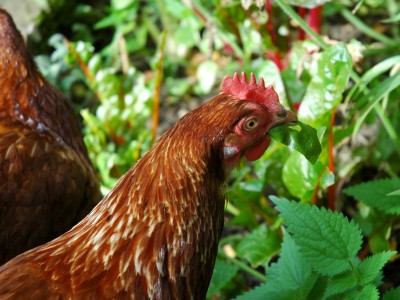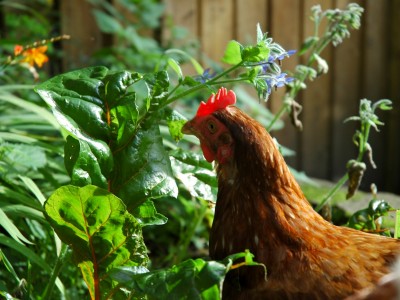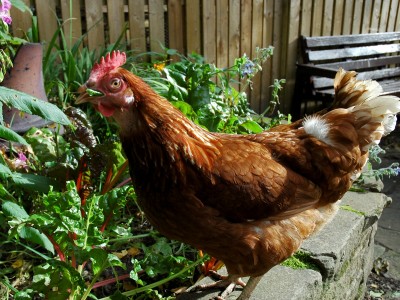Actually, make that nine edible things
After writing the last post about all the edible stuff still in the garden, I let the chickens out for a play in the garden in the sunshine.
I now no longer have any swiss chard.
I better get some bloomin’ great eggs tomorrow.
Read MoreFlu and what-have-you
So I got myself all stoked up to do stuff and blog about it to get myself back into the swing of things then I got the flu. The only thing that’s been productive around here in the last two weeks or so has been my phlegmy chest. I’m still not running at full steam but I thought I should try to hop back aboard the blogging train before all the carriages race away from me and this metaphor goes off the completely off the tracks ;)
These last few weeks have mostly been spent slumped on one sofa or another, watching a whole lot of films and eating a whole lot of soup. But in my slightly-better moments, I’ve done some sewing after getting a new embroidery book out of the library just before the virus hit (book review coming soon) and wandered down to see the chickens, lamenting about the sorry state of the garden and wondering if things will fruit/ripen before the frost hits.
The latter put me in a bit of a “I’m a bad gardener” slump until I realised that even with all the dead things, the things that won’t quite get there this year, the things that didn’t stand a chance and the lack of any summer sowing whatsoever, we’ve still got at least ten edible things growing in the garden that we can/will eat: achocha (outdoor – will pick soon), tomatoes (greenhouse & outdoor), courgettes, marrows (ok, so they’re essentially the same thing but we used them differently), cucumbers, peppers, chillis (all greenhouse), leeks, pumpkin and swiss chard.
And that’s before we get onto the wild greens/fruit (predominantly nettles but there are also some bullet-like blackberries at the end of the garden and the dregs of elderberries on the trees near the kitchen), the technically-edible-but-I-probably-won’t-eat-them-now things (like the new leaves/shoots on the squashes & the achocha, or the marigold leaves & heads) and herbs (rosemary, lavender & mint still going strong outside, basil & chives inside, and things gone to seed both outside & in that are still usable just not as good as before they flowered, like dill & oregano).
And it’s also not including eggs – the six girls are still kicking out on average five a day, which is nice.
When I’ve got a bit more energy/less mucus, I’ll write more about our growing year here – lots more lessons learnt and things to definitely not do next year – but this has made me feel a little better about things, that there have been some successes as well as the many failures.
What’s still on the go in your garden?
Read MoreCreating miniature forest gardens?
On Wednesday Linda pointed out that my sawing wood avoidance isn’t lazy but “efficient”. Yes, *cough*, efficient, I concur.
I’m trying to be as efficient as possible in the garden this year – both according to that meaning and the conventional one — and from that and some recent reading, I’m thinking of creating two small forest gardens spots in my garden.
For those not familiar with the idea, forest gardening is a way to multicrop one area – growing (usually) edible plants, shrubs and trees at up to seven different levels, from the treetop canopy levels to ground cover and even root veg. You can create them at a forest scale or even just in small container. It’s efficient in terms of space – a variety of potential food from one area – and can be efficient in the not-sawing-really-lazy sense too if most/all of the layers are perennials or self-seeders.
Both spots I’ve thinking about are in raised beds underneath trees – the first underneath a super tall 100 year old silver birch, then second under a recently planted (currently 2 years old) morello cherry. The silver birch would be canopy layer-plus-plus as it’s miles away from anything else. The cherry, which is on semi-dwarf rootstock, will grow to no more than 2.5m-3m tall so is more at the second layer, the “low tree layer”.
The idea is to have a wedge shape if at all possible – the tall things at the back, the short things at the front, so everything gets sufficient light. The trees are, usefully, in just about the right position for this – towards the back of the space (or at least with ample space to the front) and positioned so that they won’t block the sun. (The back of the house, and thus the garden, is east-facing but the southern facing aspect is completely open too so the silver birch bed gets full sun from about 10am until 4pm-5pm in the summer, and the cherry space from dawn until 2pm.)
Both spots are small and both trees will be pretty thirsty, so I probably won’t be able to plant a full set of layers of demanding fruit & veg but I think there is potential for some stuff. Even if I’m not growing huge amounts of anything in particular, as long as it’s not taking me a lot of effort, it seems to be a good use of space – especially as they’re underused/used as a dumping ground as the birch bed (at the top) is used now.
I’ve already started to plant some shrub-layer fruit bushes under the silver birch – some raspberries that’ll hopefully grow to 3ft-4ft tall. I don’t think the bed is deep enough towards the front for root veg but it’ll certainly be fine for herbaceous things — it would make sense to put borage in there (which grew to between 2-3ft last year) because it’s near the chickens who love borage and I’ve got some chard just starting off, which could go in front of that. Finally, I’m not sure I’ll have any spare plants this year but hopefully once my strawberries start multiplying, I could plant some runners as ground cover/to topple over the edge. Borage self-seeds, chard can (can’t it?) and strawberry runners will last a few years before needing swapping out – so that, in theory, sounds like it could be a lazy efficient bed.
There is only about half that space around the cherry tree so I can’t pack it out. I think big berry bushes would overwhelm the space and clash with the lower tree branches but might get away with some shorter fruit bushes – possibly a small blueberry bush (I’ve seen some that are only about 2ft tall), and when I can propagate children from my cranberry & lingonberry bushes, I could include their offspring there too (the cranberry “strands” could flop over the side of the raised bed). I guess I wouldn’t be adding either of those things this year – which would probably be good as it would let the cherry tree get established in the meantime. I wonder if there is anything not resource crazy that I could put in there now… possibly some not-moisture-crazy herbs? Rosemary? Lavender? I have some little lavender plants in the nearby herb bed which could be transplanted without too much disruption and some other rosemary plantlets nearly ready to be planted out too.
One layer I’ve not talked about is climber/vines – which is the seventh layer. If I thought kiwis or grapes would grow well enough this far up north, I’d possibly consider them for climbing up around the silver birch. Is there anything else in that category that would work? I guess I could leave some space for annual vines – “climbing” squash or something but they are very resource intensive. I’m going to make sure the beds are well enhanced with organic matter before I start but it seems silly to overload them straight afterwards.
Has anyone else created any really small scale “forest gardens”? Is there anything to watch for or need to consider? Any suggestions/advice about my initial plant choices?
Read More


